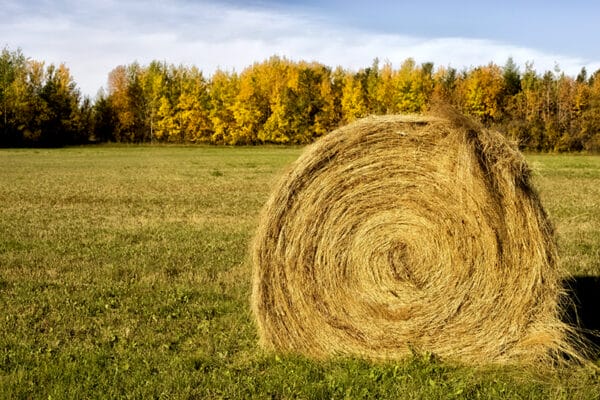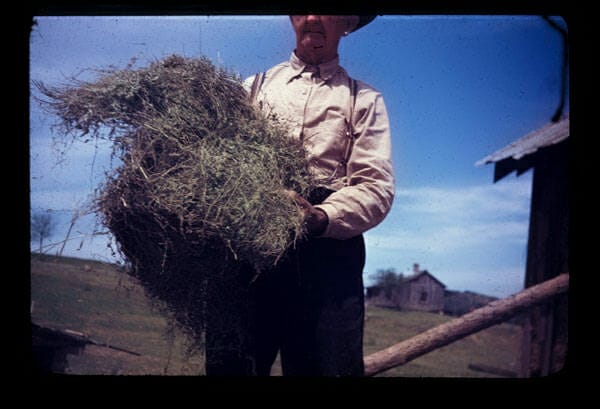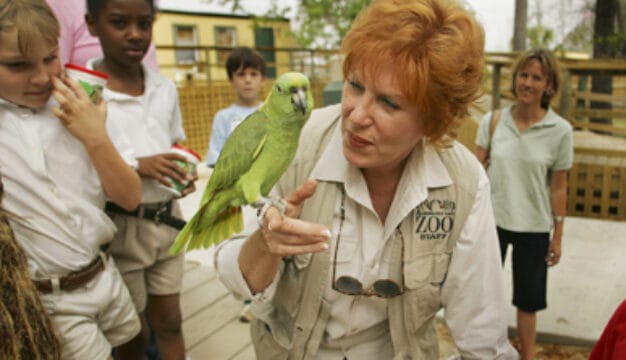Forages in Alabama
 Hay
The term “forage” is commonly used to refer to above-ground plant growth other than separated grain that is used as feed for domestic animals. Forage crops, or simply forages, are plant species grown for this purpose. Forage is most commonly consumed as pasture by grazing animals, but it also can be harvested and stored as hay or silage (dried or fermented plant material, respectively) and fed to livestock during times when pasture forage is not available. Ideally, forage is harvested or grazed when it consists mainly of green leaves and mostly immature stems rather than older, highly fibrous, and less digestible dead leaves and stemmy material. With its mild climate and abundant rural land, Alabama is well suited to the production of forage crops.
Hay
The term “forage” is commonly used to refer to above-ground plant growth other than separated grain that is used as feed for domestic animals. Forage crops, or simply forages, are plant species grown for this purpose. Forage is most commonly consumed as pasture by grazing animals, but it also can be harvested and stored as hay or silage (dried or fermented plant material, respectively) and fed to livestock during times when pasture forage is not available. Ideally, forage is harvested or grazed when it consists mainly of green leaves and mostly immature stems rather than older, highly fibrous, and less digestible dead leaves and stemmy material. With its mild climate and abundant rural land, Alabama is well suited to the production of forage crops.
Most of the nutrition for domestic grazing animals is provided by forage. Researchers have estimated that in the United States, forages provide around 63 percent of the feed consumed by dairy cattle and 84 percent for beef cattle, on average. Close to one-third of the food consumed by the average American each year originates from cattle, sheep, and goats. All of these animals are ruminants, meaning that they have a four-stomach digestive system that is adapted for efficient extraction of nutrients from forage. As the primary source of nutrition for these animals, forage is therefore a major, although indirect, contributor to the human diet. Forage crops also contribute to the diets of other domestic nonruminant animals, including swine, horses, and sometimes even poultry.
 Dairy Cows
Some forages are perennial, meaning that the plants have the ability to live for more than one year. Others are annuals that germinate, grow, and die within a 12-month period. Forages are also divided into warm-season crops, which grow most actively during the warmer months of the year (mainly summer), and cool-season crops, which grow during the cooler months of the year (mainly spring and autumn). Forages are further divided into grasses and forbs. Plants in these two categories differ in many ways, with many grasses being particularly well-suited for forage because they are hardy and productive. Most forbs used for forage are in the legume family, including clovers, alfalfa, lespedeza, and vetch, all of which are especially nutritious to grazing animals.
Dairy Cows
Some forages are perennial, meaning that the plants have the ability to live for more than one year. Others are annuals that germinate, grow, and die within a 12-month period. Forages are also divided into warm-season crops, which grow most actively during the warmer months of the year (mainly summer), and cool-season crops, which grow during the cooler months of the year (mainly spring and autumn). Forages are further divided into grasses and forbs. Plants in these two categories differ in many ways, with many grasses being particularly well-suited for forage because they are hardy and productive. Most forbs used for forage are in the legume family, including clovers, alfalfa, lespedeza, and vetch, all of which are especially nutritious to grazing animals.
Scope and Geographic Distribution
In Alabama, more than four million acres are devoted to the production of forage crops, making them second only to forestry in commercial land use in the state and surpassing all other agronomic and horticultural crops combined. More than 40 different nonnative forage crops are commonly planted in Alabama.
Before European settlement of the Southeast, most of the land in Alabama was forested and there was little opportunity for forage species to evolve. A few warm-season perennial native species, such as big bluestem, little bluestem, eastern gamagrass, and switchgrass, have forage potential and occur naturally or can be grown in many areas within Alabama. Although most livestock producers find that these grasses require more effort than is justified by the benefits of growing them strictly for forage, such native species are often planted for wildlife purposes.
The economic value of forage production is largely expressed through the sale of the animals that consume pasture, hay, and silage. The exceptions are local growers who produce hay for sale to others, mainly livestock producers. On most livestock farms in Alabama, pasture or hay land is dominated by one or more perennial grasses.
Tall fescue, a cool-season perennial grass, is the dominant forage species in the northern half of Alabama, particularly in the Limestone Valleys and Uplands, Sand Mountain, the Appalachian Plateau, and the Piedmont. The warm-season perennials bermudagrass and bahiagrass are dominant species in the southern half of the state, especially in the Coastal Plain. Dallisgrass and Johnsongrass, also both warm season perennial grasses, and tall fescue, are significant forages in the Blackland Prairie.
 Tall Fescue
White clover, a cool-season perennial legume, is commonly grown as a companion species to tall fescue and dallisgrass. Sericea lespedeza is a warm-season perennial legume grown mostly in the northern half of the state. Various combinations of cool-season annual grasses, such as ryegrass and cereal grains (especially rye, wheat, or oats) and various annual legumes, including crimson clover, red clover, and arrowleaf clover, are often grown either on a prepared seedbed or seeded into the dormant sods of warm-season perennial grasses. Cool-season annuals are grown throughout Alabama but are more productive and more widely used in the southern portions of the state.
Tall Fescue
White clover, a cool-season perennial legume, is commonly grown as a companion species to tall fescue and dallisgrass. Sericea lespedeza is a warm-season perennial legume grown mostly in the northern half of the state. Various combinations of cool-season annual grasses, such as ryegrass and cereal grains (especially rye, wheat, or oats) and various annual legumes, including crimson clover, red clover, and arrowleaf clover, are often grown either on a prepared seedbed or seeded into the dormant sods of warm-season perennial grasses. Cool-season annuals are grown throughout Alabama but are more productive and more widely used in the southern portions of the state.
Other Benefits
Forage crops provide both nutrition and cover for many species of wildlife and game animals, including white-tailed deer, rabbits, and turkey. In fact, many thousands of acres of forage crops are planted for wildlife in Alabama each year. Many hunters do so to increase the populations and nutritional status of wild game animals and birds or to attract them for hunting. Forage crops, particularly perennial sod-forming grasses, are among the most effective ground covers for preventing soil erosion, and they therefore help to protect water quality. They are widely planted to stabilize road banks, reclaim mined areas, and otherwise protect and reclaim soil that has been disturbed or is prone to erosion.
 Hay Produced in Calhoun County
Some Alabama farmers obtain a significant portion of their income by producing seeds of various forage crops, including bahiagrass, sericea lespedeza, browntop millet, and several annual clovers. Forage crops are also an important source of nectar and pollen for the bee industry, and bees in turn are effective pollinators that benefit the production of many other crops, particularly fruits and vegetables. In addition, forage crops are often planted in rotations with row crops such as cotton and peanuts. Crop rotation interrupts pest cycles, increases organic soil matter, and improves soil structure, thus raising the yield of row crops. Finally, forage crops contribute much beauty to rural landscapes.
Hay Produced in Calhoun County
Some Alabama farmers obtain a significant portion of their income by producing seeds of various forage crops, including bahiagrass, sericea lespedeza, browntop millet, and several annual clovers. Forage crops are also an important source of nectar and pollen for the bee industry, and bees in turn are effective pollinators that benefit the production of many other crops, particularly fruits and vegetables. In addition, forage crops are often planted in rotations with row crops such as cotton and peanuts. Crop rotation interrupts pest cycles, increases organic soil matter, and improves soil structure, thus raising the yield of row crops. Finally, forage crops contribute much beauty to rural landscapes.
Future Potential
Alabama’s climate is well suited to growing forage crops. However, a great deal of the land currently devoted to these crops could be much more productive if it were managed more intensively, especially through more precise fertilization, better grazing management, and weed control. Furthermore, many thousands of acres of land in the state are currently underused but would make excellent pasture or hay land with proper management. Although the potential of forage crops has not been fully realized, they already make many contributions. In addition, the potential for biomass energy production from switchgrass and other forage species is currently being explored.
Further Reading
- Ball, Donald M., Carl S. Hoveland, and Garry D. Lacefield. Southern Forages. 5th ed. Peachtree Corners, Ga.: International Plant Nutrition Institute, 2015.



